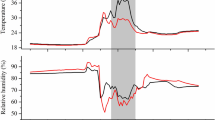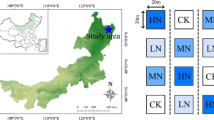Abstract
This research is an attempt to study seasonal translocation patterns of photoassimilated carbon within trees of one of the high latitudes widespread deciduous conifer species Larix gmelinii (Rupr. Rupr). For this purpose, we applied whole-tree labeling by 13CO2, which is a powerful and effective tool for tracing newly developed assimilates translocation to tissues and organs of a tree. Experimental plot has been established in a mature 105-year-old larch stand located within the continuous permafrost area near Tura settlement (Central Siberia, 64°17′13″N, 100°11′55″E, 148 m a.s.l.). Measurements of seasonal photosynthetic activity and foliage parameters (i.e., leaf length, area, biomass, etc.), and sampling were arranged from early growing season (June 8, 2013; May 14, 2014) until yellowing and senescence of needles (September 17, 2013; September 14, 2014). Labeling by 13C of the tree branch (June 2013, for 3 branch replicates in 3 different trees) and the whole tree was conducted at early (June 2014), middle (July 2014), and late (August 2013) phase of growing season (for different trees in 3 replicates each time) by three pulses [(CO2)max = 3000–4000 ppmv, 13CO2 (30 % v/v)]. We found at least two different patterns of carbon translocation associated with larch CO2 assimilation depending on needle phenology. In early period of growing season (June), 13C appearing in newly developed needles is a result of remobilized storage material use for growth purposes. Then approximately at the end of June, growth processes is switching to storage processes lasting to the end of growing season.



Similar content being viewed by others
References
Bruggemann N, Gessler A, Kayler Z, Keel SG, Badeck F, Barthel M, Boeckx P, Buchmann N, Brugnoli E, Esperschutz J, Gavrichkova O, Ghashghaie J, Gomez-Casanovas N, Keitel C, Knoh A, Kuptz D, Palacio S, Salmon Y, Uchida Y, Bahn M (2011) Carbon allocation and carbon isotope fluxes in the plant-soil-atmosphere continuum: a review. Biogeosciences 8:3457–3489
Epron D, Bahn M, Derrien D, Lattanzi FA, Pumpanen J, Gessler A, Högberg P, Maillard P, Dannoura M, Gérant D, Buchmann N (2012) Pulse-labelling trees to study carbon allocation dynamics: a review of methods, current knowledge and future prospects. Tree Physiol 32:776–798
Jarvis PG, Dewar RC (1993) Forests in the global carbon balance: from stand to region. In: Ehleringer JR, Field CB (eds) Scaling physiological processes, leaf to globe. physiological ecology. Academic Press, San Diego, pp 191–222
Kagawa A, Sugimoto A, Maximov TC (2006) Seasonal course of translocation, storage and remobilization of 13C pulse-labeled photoassimilate in naturally growing Larix gmelinii saplings. New Phytol 171:793–804
Kajimoto T, Matsuura Y, Sofronov M, Volokitina A, Mori S, Osawa A, Abaimov A (1999) Above- and belowground biomass and net primary productivity of a Larix gmelinii stand near Tura, central Siberia. Tree Physiol 19:815–822
Kajimoto T, Osawa A, Usoltsev V, Abaimov A (2010) Biomass and productivity of Siberian larch forest ecosystems. In: Osawa A, Zyryanova O, Matsuura Y, Kajimoto T, Wein R (eds) Permafrost ecosystems: Siberian larch forests. Ecological studies, vol 209. Springer, Dordrecht, pp 99–122
Keel SG, Campbell CD, Hogberg MN, Richter A, Wild B, Zhou X, Hurry V, Linder S, Nasholm T, Hogberg P (2012) Allocation of carbon to fine root compounds and their residence times in a boreal forest depend on root size class and season. New Phytol 194:972–981
Koike T, Hojyo H, Naniwa A, Ashiya D, Sugata S, Sugishita Y, Kobayashi M, Nomura M, Akibayashi Y, Nakajima J, Takagi K, Shibata H, Satoh F, Wang W, Takada M, Fujinuma Y, Shi F, Matsuura Y, Sasa K (2001) Basic data for CO2 flux monitoring of a young larch plantation: current status of a mature mixed conifer-broadleaf forest stand. Eur J For Res 2:65–79
Nakai Y (2010) Net ecosystem exchange of CO2 in permafrost larch ecosystems. In: Osawa A, Zyryanova O, Matsuura Y, Kajimoto T, Wein R (eds) Permafrost ecosystems: Siberian larch forests. Ecological studies, vol 209. Springer, Dordrecht, pp 183–203
Prokushkin A, Bogdanov V, Evgrafova S, Bugaenko T, Bezkorovaynaya I, Kirdyanov A, Knorre A, Prokushkin S (2008) Surface fires influence on soil organic carbon in permafrost zone of Siberia. In: Baranchikov Yu et al (eds) Proceedings of conference “Fires in forest ecosystems of Siberia”, IF SB RAS. Krasnoyarsk, Russia, pp 169–172
Shi F, Qu L, Wang W, Matsuura Y, Koike T, Sasa K (2002) Aboveground biomass and productivity of Larix gmelinii forests in Northeast China. Eur J For Res 5:23–32
Shibuya M, Saito H, Sawamoto T, Hatano R, Yajima T, Takahashi K, Cha J, Isaev A, Maximov T (2002) Time trend in aboveground biomass, net primary production, and carbon storage of natural Larix gmelinii stands in eastern Siberia. Eur J For Res 7(2):67–74
Streit K, Rinne KT, Hagedorn F, Dawes MA, Saurer M, Hoch G, Werner RA, Buchmann N, Siegwolf RTW (2013) Tracing fresh assimilates through Larix decidua exposed to elevated CO2 and soil warming at the alpine treeline using compound-specific stable isotope analysis. New Phytol 197:838–849
Wang W, Zu Y, Wang H, Matsuura Y, Sasa K, Koike T (2005) Plant biomass and productivity of Larix gmelinii forest ecosystems in northeast China: intra- and inter-species comparison. Eur J For Res 8(1):21–41
Acknowledgments
We would like to thank staff of laboratory of biogeochemical cycles in forest ecosystems at V.N. Sukachev Institute of Forest Siberian Branch, namely Tsukanov A.A., Timokhina A.V., Klimchenko A.V., Panov A.V. for the various technical assistance during fieldworks at Tura Station (Evenkia, Russian Federation). This work was partly supported by the Russian Foundation of Basic Research (Grant No 13-04-00659-a) and by the Russian Science Foundation (14-24-00113).
Author information
Authors and Affiliations
Corresponding author
Ethics declarations
Conflict of Interest
The authors declare that they have no conflict of interest.
Rights and permissions
About this article
Cite this article
Masyagina, O., Prokushkin, A., Kirdyanov, A. et al. Intraseasonal carbon sequestration and allocation in larch trees growing on permafrost in Siberia after 13C labeling (two seasons of 2013–2014 observation). Photosynth Res 130, 267–274 (2016). https://doi.org/10.1007/s11120-016-0250-1
Received:
Accepted:
Published:
Issue Date:
DOI: https://doi.org/10.1007/s11120-016-0250-1




